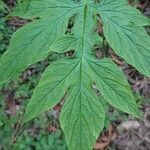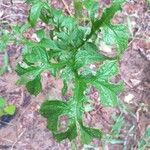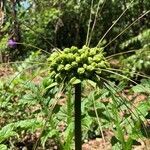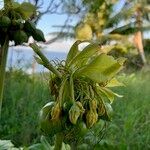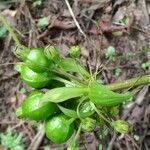Tuber depressed-globose or broadly ellipsoid, thin-skinned, smooth, 1.5-5 cm high by 1-8 by 0.5-4 cm, white when young, older dark grey to brown, white within, somewhat juicy, growing near the surface to up to 50 cm deep, provided with an apical cavity emitting the leaves and inflorescences; the tuber is replaced during the year by a new main tuber which arises from a downward-growing runner-like thick rhizome at a lower level and remains dormant after yearly death of aerial parts of the original plant. Base of the leaves and the inflorescence in young plants (mostly?) surrounded by a linear-lanceolate, special leaf (cataphyll) 8-21 by 1.2-3 cm. Leaves 1-3, broadly obovate, ovate, or oblong-ovate in outline, palmately 3-sect, each of the 3 segments pinnately lobed to dissected, up to 70 by 120 cm; lobes orbicular to linear; petiole hollow, 17-150 by 0.3-2.5 cm, sheath 2-25 by 0.6-3.5 cm. Inflorescences 1 or 2, 20-40-flowered; scape hollow, green, 20-170 by 0.2-2.5 cm. Involucral bracts of different size, large ones 4-9 (-12), mostly surrounding the scape, sometimes only on the ribbed side of the scape (in that case with up to 10 small bracts in the canaliculate zone), light to dark green, sometimes with fine purplish margin, 2 (-4) outer ones sessile, (ob)ovate, oblong, or lanceolate, 2.5-10 by 1.2-3.5 cm, with attenuate or cuneate base, acuminate at the apex, acumen entire or 2-3 dentate; 2-7 (-10) inner bracts more or less similar in shape to the outer ones, acuminate at the apex, curvinerved with pinnate side nerves, 2.5-10 by 0.7-5 cm; the small bracts linear lanceolate, sessile, with acute apex, 5-7 by 1-1.5 mm. Filiform bracts 20-40, up to 25 cm, (dark) purple or dark blackish-brown. Flowers 6-17 by 6-13 mm, drooping, light yellow, yellowish green or blackish purplish green; pedicel up to 6 cm by 1 mm (in fruit up to 8 cm by 2 mm); perianth tube 1.5-5 by 4-11 mm. Perianth lobes mostly fleshy with membranous margins, persistent, 3 outer ones elliptic or ovate (lanceolate), (1.5-) 4-7 by 2-3 mm, 3 inner ones (broadly) ovate or oblong ovate, 5-7.5 by 2.5-5 mm; apices obtuse or retuse, rarely truncate. Stamens white or dull yellow to brown or purple; adnate portion of the filaments 1-5 by 2-2.5 mm, free apical portion 1.5-2 by 1.5-2 mm, thecae up to 2 mm long. Ovary 2-5 by 2-4 mm; disk annular, ribbed, (always?) with numerous pellucid glandular hairs, 1.5-3 mm ø; style 1.5-3 by 0.5-1.5 mm, whitish to green; stigmatic lobes whitish to purple, 1.5-2 by 2-3 mm, sometimes their 2 apices emarginate. Fruit mostly globose, 1.5-2.5 cm ø, but sometimes ellipsoid or ovoid, up to 3.5 by 1.5-2.5 cm, pendulous, pale to darker green, finally pale orange; pericarp up to 1.5 mm thick. Seeds many, ovoid to ellipsoid, flattened, 5-8 by 3-5 by 1.5-3 mm glabrous, yellowish brown, with a spongy white testa, 15-19-ribbed.
More
A perennial herb with no stem but leaves up to 1 metre long and divided into 3 segments. The leaf stalks are 1.5 to 2 cm across and about 1 m long. The leaves are 1 to 1.5 m across and divided into 3 parts which are again divided. A single flower stem grows up beside the leaf stem. The flowers are green and purplish on top of a 1 m long flower stalk. There can be 30-40 small flowers and several long spreading and drooping coloured bracts or long thin threads hang from the flower. The leaf and flower stalks are hollow and ribbed which helps distinguish it from the somewhat similar looking leaf of elephant foot yam (where it is smooth and solid). The fruits are yellowish green, long shaped and with 6 raised lines along the side. They can be 4 cm long and 2 cm wide and have several seeds inside. Under the ground there is a round swollen root or tuber. It can be 30 cm across and weigh 1 kg. Some varieties produce several smaller tubers.
Leaves few; petiole to 1.5 m long, usually less than 1 m; lamina trisect at base, irregularly pinnate and pinnatisect or pinnatifid; lobes variable within and between plants, from narrowly lanceolate and c. 2–3 mm long to broadly ovate and c. 10 cm long, with rounded to acuminate apex. Inflorescence scapes 1 or 2, to 1.7 m long; involucral bracts 4–12, lanceolate to ovate, 1–4 cm long, usually entire; flowers 20–40; pedicels to 6 cm long; 'floral bracts' c. 20–40, filiform, mostly 10–15 cm long. Sepals lanceolate, c. 6 mm long, 1–1.5 mm wide, yellow, green or purple-green. Petals 1.5–2 mm wide. Style c. 2 mm long, with 3 glandular knobs at base. Fruit ribbed, ovoid, c. 2.5 cm long, crowned with persistent perianth, indehiscent. Seeds many.
Tubers globose to broadly ellipsoid-globose; cork dark gray to brown; transverse section white. Leaf blade broadly obovate, ovate, or oblong-ovate, palmately 3-lobed; lobes pinnately lobed. Involucral bracts 4--12; umbel 20--40 flowered. Bracteoles to 25 cm. Perianth pale yellow, pale yellowish green, or dark purplish green; outer lobes elliptic to ovoid, inner ones broadly to narrowly ovate. Berry drooping, globose, ellipsoid-globose, or ovoid-globose. Seeds many, flattened globose; testa spongy.
